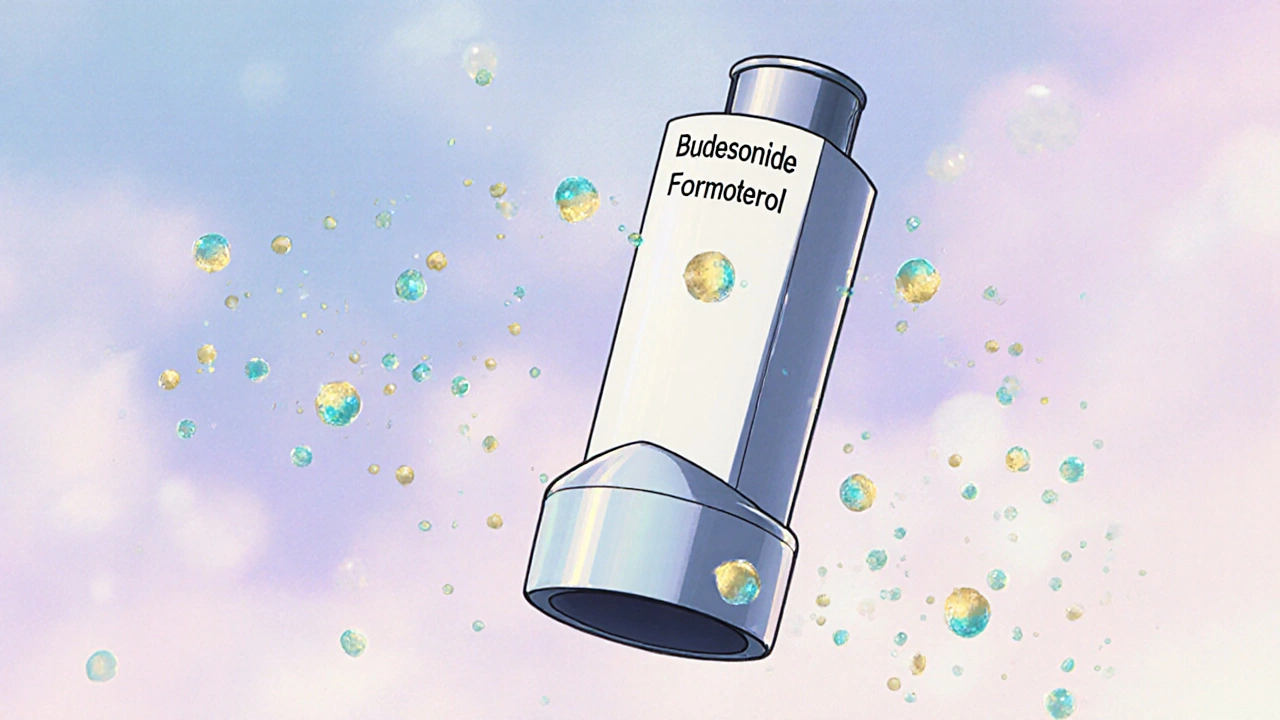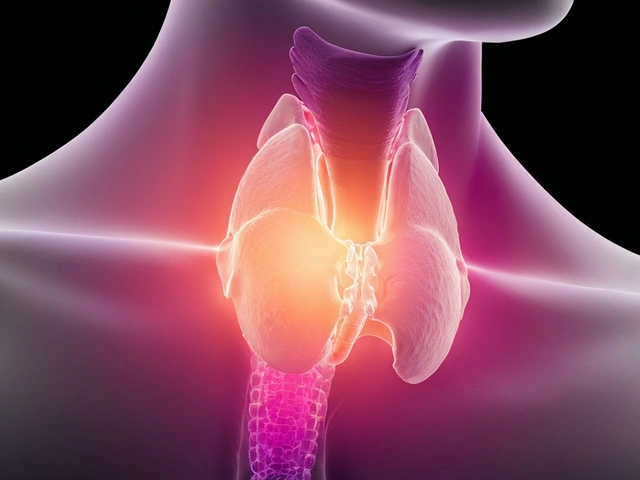
Key Takeaways
- Budesonide Formoterol combines an inhaled corticosteroid (ICS) with a long‑acting β2‑agonist (LABA) for fast and lasting relief.
- The steroid component reduces airway inflammation by binding to glucocorticoid receptors and turning off inflammatory genes.
- Formoterol relaxes smooth‑muscle via β2‑adrenergic receptors, opening airways within minutes and staying active for up to 12 hours.
- The synergy allows a single inhaler to be used as both maintenance and quick‑relief (SMART) therapy for many asthma patients.
- Side‑effects are generally mild but can include oral thrush, hoarse voice, and rare heart‑rate changes.
When you pick up an inhaler labeled Budesonide Formoterol, you’re holding a tiny laboratory that tackles two problems at once: inflammation and muscle tightening. Understanding how it works helps you use it more confidently and may improve your symptom control.
Budesonide Formoterol is a combined inhaled medication that pairs the corticosteroid budesonide with the long‑acting β2‑agonist formoterol. It is marketed under brand names such as Symbicort and is prescribed for asthma and chronic obstructive pulmonary disease (COPD).
What Is Budesonide Formoterol?
The product contains two active ingredients:
- Budesonide is an inhaled corticosteroid (ICS) that dampens airway inflammation. It belongs to the glucocorticoid class and has a high topical potency with low systemic absorption.
- Formoterol is a long‑acting β2‑adrenergic agonist (LABA) that relaxes bronchial smooth muscle. Its rapid onset (within minutes) and 12‑hour duration make it ideal for maintenance plus rescue use.
Both molecules are delivered together via a metered‑dose inhaler (MDI) or a dry‑powder inhaler (DPI), ensuring they reach the same airway regions at the same time.
How the Two Components Work Separately
Inhaled Corticosteroids - The Anti‑Inflammatory Engine
Once inhaled, budesonide diffuses across the airway epithelium and binds to the intracellular glucocorticoid receptor. The receptor‑ligand complex then travels to the nucleus, where it either up‑regulates anti‑inflammatory proteins (like annexin‑1) or down‑regulates pro‑inflammatory genes (such as IL‑4, IL‑5, and TNF‑α). The net effect is reduced eosinophil infiltration, less mucus production, and a thicker, more stable airway wall.
Long‑Acting β2‑Agonists - The Bronchodilator Booster
Formoterol’s molecular shape allows it to fit snugly into the β2‑adrenergic receptor on airway smooth‑muscle cells. Activation triggers a cascade that raises cyclic AMP (cAMP) levels, activating protein kinase A (PKA). PKA phosphorylates myosin‑light‑chain kinase, preventing muscle contraction and causing relaxation. Because formoterol is lipid‑soluble, it lodges in the cell membrane and releases slowly, sustaining the bronchodilatory effect for up to 12 hours.

The Synergy: Why Combine Them?
Combining an ICS with a LABA does more than add two effects together-it creates a feedback loop that enhances each drug’s performance:
- Improved adherence: One inhaler replaces the need for separate daily steroids and rescue bronchodilators.
- Reduced dose requirements: LABA‑induced bronchodilation improves airway deposition of the steroid, allowing lower overall steroid doses.
- SMART therapy: The rapid onset of formoterol lets the same inhaler serve as rescue medication, while the budesonide component continuously controls inflammation.
- Enhanced safety: When used as directed, the risk of LABA‑related asthma‑related deaths declines because the steroid is always present to keep inflammation in check.
Pharmacokinetics and Delivery Mechanics
The inhaler device itself is a key part of the science. Both MDI and DPI versions produce particles in the 1‑3 µm range-small enough to bypass the oropharynx and deposit deep in the bronchi and bronchioles.
After deposition:
- Budesonide reaches peak plasma concentration within 30 minutes but largely remains bound to airway tissue. Systemic exposure is less than 10 µg per dose, minimizing adrenal suppression.
- Formoterol appears in the bloodstream within minutes, correlating with the bronchodilator effect that patients feel almost instantly.
Both drugs are metabolized by the liver (primarily CYP3A4). Because the inhaled doses are low, drug‑drug interactions are rare, but clinicians still caution against potent CYP3A4 inhibitors (e.g., ketoconazole) that could raise systemic steroid levels.
Clinical Applications
Asthma Management
Guidelines from GINA (Global Initiative for Asthma) recommend Budesonide Formoterol as a preferred option for step 2-4 therapy and as the sole reliever in the SMART approach. Clinical trials have shown a 30 % reduction in severe exacerbations compared with using a separate SABA (short‑acting β2‑agonist) for rescue.
Chronic Obstructive Pulmonary Disease (COPD)
For COPD, the medication improves FEV₁ (forced expiratory volume in one second) by about 100 mL and reduces rescue inhaler use by 40 % over six months. It is especially useful in patients who experience frequent dyspnea despite long‑acting bronchodilators alone.
SMART (Single‑Maintenance‑And‑Reliever Therapy)
SMART leverages formoterol’s quick onset. Patients take two inhalations twice daily for maintenance and add one inhalation whenever they feel symptoms. Studies (e.g., SYGMA 1 and SYGMA 2) demonstrated that SMART achieved similar control to high‑dose inhaled steroids but with fewer systemic side‑effects.

Common Side Effects and Safety Considerations
While Budesonide Formoterol is generally well tolerated, watch for:
- Oral candidiasis (thrush) - rinse mouth after each use.
- Hoarse voice - also mitigated by rinsing.
- Transient tachycardia or palpitations - usually mild, linked to formoterol’s systemic absorption.
- Potential bone density loss with long‑term high steroid exposure - keep doses as low as possible.
If you notice worsening asthma symptoms despite regular use, contact a healthcare professional; it may signal that the dose needs adjustment.
How It Stacks Up Against Other Combination Inhalers
| Product (Brand) | ICS Component | LABA Component | Typical Dose (µg) | Onset | Duration |
|---|---|---|---|---|---|
| Symbicort | Budesonide (80‑160) | Formoterol (4.5‑9) | 160/4.5 µg BID | Minutes | 12 h |
| Advair / Seretide | Fluticasone propionate (100‑250) | Salmeterol (50) | 250/50 µg BID | 10‑20 min | 12 h |
| Pulmicort Flexhaler (alone) | Budesonide (200‑400) | - | 200‑400 µg BID | - | 12 h |
Notice that Budesonide Formoterol offers the fastest onset among the listed combos, thanks to formoterol’s intrinsic rapid action. It also provides a lower steroid dose for comparable control, which can be advantageous for patients worried about systemic exposure.
Frequently Asked Questions
Can I use Budesonide Formoterol as a rescue inhaler?
Yes, when prescribed under the SMART regimen you can take an extra inhalation for sudden symptoms. The formoterol component works within minutes, giving quick relief while the budesonide continues to treat inflammation.
Do I need to use a spacer with the inhaler?
For the metered‑dose version, a spacer can improve lung deposition, especially in children or during severe attacks. The dry‑powder version does not require a spacer.
What should I do if I miss a dose?
Take the missed dose as soon as you remember, unless it’s within an hour of the next scheduled dose. In that case, skip the missed one and continue with your regular schedule.
Is there a risk of using a LABA without a steroid?
Yes. LABAs alone can increase the chance of severe asthma episodes because they relax muscles but do not address the underlying inflammation. That’s why they are always paired with an inhaled corticosteroid.
Can pregnant women use this inhaler?
Doctors often consider it safe; the inhaled route limits systemic exposure. However, any medication during pregnancy should be discussed with a healthcare provider.
By grasping the chemistry behind budesonide formoterol, you can make informed choices about dosage, technique, and when to seek help. The combo packs a powerful anti‑inflammatory punch with a fast‑acting bronchodilator, giving many patients a simpler, more effective way to keep their lungs clear.





Lionel du Plessis
October 25, 2025 AT 18:10Budesonide engages the intracellular glucocorticoid receptor triggering transrepression of pro‑inflammatory genes while up‑regulating annexin‑1; formoterol occupies β2‑adrenergic receptors driving cAMP rise and smooth‑muscle relaxation.
Andrae Powel
October 25, 2025 AT 19:00It's important to rinse your mouth after each dose to prevent oral thrush and keep your voice clear; also mastering the inhaler technique-slow, deep inhalation for DPIs or a full‑stroke actuation with a spacer for MDIs-maximizes drug deposition in the lower airways, boosting effectiveness.
Jennie Smith
October 25, 2025 AT 20:06Think of your inhaler as a tiny two‑in‑one superhero cape-budesonide fights the hidden inflammation villains while formoterol swoops in for a fast‑acting rescue, giving you that “breath of fresh mountain air” feeling when an attack strikes.
Anurag Ranjan
October 25, 2025 AT 20:56Exactly, and because the particle size is 1‑3 µm the combo reaches the bronchioles efficiently; this is why adherence improves when patients use a single device.
James Doyle
October 25, 2025 AT 21:46When physicians prescribe Budesonide Formoterol they are endorsing a paradigm that balances anti‑inflammatory potency with bronchodilator agility, a balance that should be celebrated rather than vilified. The pharmacodynamics of budesonide-glucocorticoid receptor affinity, transrepression of NF‑κB pathways, and up‑regulation of anti‑inflammatory lipocortin-constitute a cornerstone of modern asthma management. Simultaneously, formoterol’s high intrinsic efficacy at β2‑adrenergic receptors ensures rapid cAMP accumulation, leading to smooth‑muscle relaxation within minutes. This dual mechanism not only reduces exacerbation frequency but also minimizes systemic corticosteroid exposure, a fact that aligns with the ethical imperative to “do no harm.” Moreover, the SMART regimen leverages the rapid onset of formoterol to replace separate SABA rescue inhalers, streamlining patients’ therapeutic regimens and reducing the risk of medication errors. Critics who cling to antiquated monotherapy approaches ignore robust evidence from SYGMA 1 and SYGMA 2 that combination therapy yields superior control with fewer adverse events. The pharmacokinetic profile, featuring low oral bioavailability of budesonide and limited systemic absorption of formoterol, further underscores the safety of this regimen when used as directed. In a world where healthcare costs are spiraling, the reduced need for multiple inhalers translates into tangible economic benefits for both patients and insurers. Clinicians have a moral duty to prescribe evidence‑based combinations rather than perpetuating the status quo of fragmented therapy. Additionally, the particle engineering that produces 1‑3 µm aerosols ensures optimal deposition beyond the oropharynx, maximizing clinical efficacy. Patients who adhere to proper inhaler technique-slow, deep inhalation for DPIs or a full‑stroke actuation with a spacer for MDIs-experience the full therapeutic potential of the formulation. It is incumbent upon healthcare providers to educate patients on mouth rinsing to prevent candidiasis, thereby maintaining the safety profile of the steroid component. The risk of tachycardia or palpitations from systemic formoterol exposure remains minimal when dosing guidelines are respected, contradicting sensationalist claims of cardiovascular danger. Regulatory agencies worldwide have endorsed this combination as a first‑line option for step‑2 to step‑4 asthma therapy. In summary, Budesonide Formoterol embodies a sophisticated convergence of molecular pharmacology, device engineering, and patient‑centered care that should be embraced without reservation.
Edward Brown
October 25, 2025 AT 22:53The data may look convincing but the single‑inhaler push aligns with pharmaceutical market consolidation, data framing, and subtle prescriber pressure that is rarely disclosed in glossy brochures.
ALBERT HENDERSHOT JR.
October 26, 2025 AT 00:00Keep up the good work on mastering your inhaler technique; consistency and confidence are key to managing asthma effectively 😊.
Suzanne Carawan
October 26, 2025 AT 01:06Oh sure, because a smiley face totally guarantees you’ll never forget to rinse after each puff, right?
Kala Rani
October 26, 2025 AT 02:30Actually the inhaler is overrated.